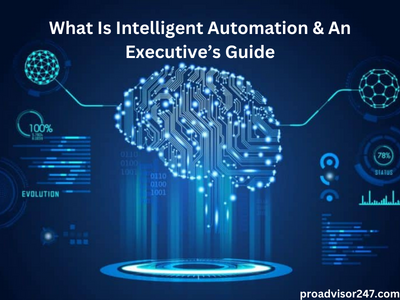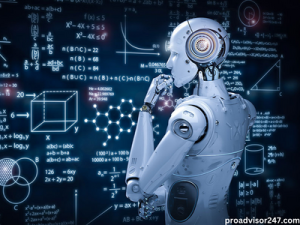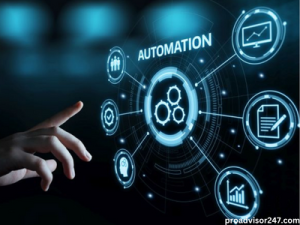
Automation in tandem with Artificial Intelligence (AI) and Machine Learning (ML) is at the forefront of the Fourth Industrial (or rather technological) revolution, which is ushering the most radical economic and social changes since the industrial revolution of the 18th century.
These technological exploits are transforming our world and changing our social spaces as well as workplaces. Artificial intelligence, machine learning, or intelligent automation is not limited to industrial or scientific procedures anymore. These are slowly encroaching into our private and public life to perform even menial tasks once helmed by human laborers. The experiences and technologies developed by the likes of IBM’s Watson, DeepMind, and Google’s driverless car are now steadily trickling down to the smallest of elements, which can be witnessed easily around us.
IA initially was limited to manufacturing processes, but slowly started taking over various other functions and processes. It is now an integral part in various enterprise functions as it has the potential to transform entire industries and businesses. Any organization or business endeavor that doesn’t recognize the necessity of introducing IA in relevant aspects of their enterprise functions is surely risking its future.
Since 2017, there has been a significant rise in the number of organizations adopting end-user process automation by using Robotics Process Automation (RPA). Many enterprises have realized the possibility of immense improvement in production quality and quantity through the implementation of RPA. Also, after implementing intelligent automation into traditional processes, enterprises save a substantial amount of costs. This is possible due to the elimination of inefficient processes and utilizing the same resources better.
How are these organizations using intelligent automation to give impetus to their businesses?
Automation in an enterprise setup mostly starts with the objective of reducing effort and maximizing output, essentially by eliminating the tedious, repetitive, and risky tasks, where humans are not as efficient as machines.
As per a recent study, as much as 45 percent of existing work activities could now be automated using existing technologies. Experts claim that this is only the beginning, as the automation potential will exponentially increase with the advancement in artificial intelligence and its variants. Existing automation technology is already on par with the required human performance and in many cases excess human performance vastly.

There are many great examples in front of us that demonstrate this potential, for example, Amazon is already using Kiva robots that plan, navigate, and coordinate among different robot entities to fulfill warehouse orders faster than its previous warehouse system.
To Know More About Azure IoT And It’s Services CLICK HERE.
How traditional jobs are being replaced with new-age ones, assisted by intelligent automation?
There is no denying that automation and its variants are changing the majority of existing jobs and occupations, which will have a significant impact on our understanding of jobs and business processes. For example, mortgage-loan officers will not spend any time inspecting and processing paperwork but will review exceptional instances that will allow them to increase the number of loans processed.
This will also provide a more advisory component to the job and as a result, overhaul the entire understanding of it. Another significant area where automation might change the world is healthcare. Diagnosis is the backbone of the modern health industry and with IA, health issues and symptoms could be effectively identified without any assistance from a medical officer or laboratory. Only a sophisticated robot with access to vast amounts of data could diagnose a gamut of health issues and push doctors to handle severe or critical cases, where they would focus on advanced medicine or treatment inaccessible to the machines.
Intelligent machines will augment human capabilities and enhance the quality of work in all aspects of our daily lives. Doctors and medical researchers will be focusing on improving public health; lawyers will be saving effort and time by using text-mining techniques to read through documents and dwell only into relevant materials for critical review.
Is your organization ready to adopt IA?
To answer this, it is important to understand whether the business processes of your enterprise have tasks or jobs that can be automated and then understand what will be the impact of this adoption.
Conventionally low-skill, low-wage tasks are the ones most susceptible to automation. However, recent researches suggest that a vast majority of ‘high-skill’ and highest-paid occupations (for example, financial planners and physicians) can also be automated using current and upcoming technologies. Mundane and laborious tasks such as report analysis, operational decisions, staff assignments, and reviewing statuses can be easily automated to save cost, time, and human effort.
And contrary to popular perception, there are many ‘low-skill’ and lower-wage occupations (for example, landscapers and maintenance workers) where minimal activities and tasks could be automated with the available automation technologies. This is why you should explore there these two approaches of identifying automation feasibility – problem-driven approach and solution-driven approach.
In a problem-driven approach, organizations are mostly aware that there are some problems and inefficiencies in their daily processes, which must be addressed for better productivity. If you are using this approach, you may start by identifying the blockers in your organization’s processes and look for tasks where many employees are involved to complete repetitive operations. The following pointers may help in this problem-driven approach:
- Are there blockers that are affecting daily operations?
- Which business processes are causing blockers?
- Which tasks are taking up most of the employees’ time?
- Which tasks are mundane and repetitive, and how much time and human effort do they take?
Then there is the solution-driven approach, where organizations do not have evident blockers in their business processes but are looking for ways to better quality and enhance productivity by using automation. This approach mostly helps organizations further optimize their processes. You may use the following pointers for a solution-driven approach:
- Which performance criteria are crucial?
- Which KPIs impact our operations the most?
- Which business processes need faster turnaround time?
- Which of the key employees are performing menial tasks?
You can answer the first part of our question using these two approaches and consider benefitting from intelligent automation. Now that we have the means of identifying processes to automate, let’s look at the impact part of the question.

Recent research by Gallup points out that a vast majority of workers, about 71%, are unengaged in their jobs but they acknowledge the significance of their jobs in their lives. So if your organization is also full of employees who recognize the importance of jobs but are unengaged, that means your workers are underperforming and impacting productivity. Automating such tasks intelligently will address the problem of disengaged employees, and enhance the turnover rate significantly.
Less repetitive tasks will free up quality time for your employees and workers to add value to a different aspect of their role. It will also improve employee decision-making and augment human intelligence as mentioned earlier. Similar to a few other preceding examples, we can think of interior designers not being involved in measurements or illustrations, and focusing on developing innovative designs and environmentally sustainable solutions. In the case of financial advisors, practitioners can spend more time in processing needs and providing out-of-the-box options.
The Beginner’s Guide to Content Management Systems (CMS) Tutorial CHECK HERE.
More time, effort, and emphasis on innovative and out-of-the-box solutions will ensure customers get the best service and experience in every situation. Automation will not only open avenues for sophisticated solutions but also give access to services. It has already been established that better and easy service leads to more business, customer satisfaction, and positive word of mouth further brand recognition and loyalty in the long term.
Companies that improve on customer experience also reportedly increase in revenue, which makes it all more significant more organizations to consider intelligent automation. But revenue and profit are not all that matter. There are far more profound questions staring our way as we leap toward a new automated world. With large-scale automation and job redefinition, more and more people are at the risk of losing out or their skills and jobs becoming obsolete.
Substantial human costs, job losses, and economic inequality are the next set of questions that must be addressed by organizations and governments before making individuals dispensable. Every step towards automation will need predefined mitigating measures to up-skill, retrain, and discover new roles for all such out-of-work individuals. It is important to understand that these are the same people who are also consumers after their jobs; it’s a cycle that needs to go on for organizations to exist and prosper.
Moreover, as data is the basis of automation and its variants, data privacy, and user data protection will take precedence in government policy decisions and public focus, legal and regulatory implications are still an unexplored territory. For example, in case of an incorrect diagnosis by an automated health center or a financial miscalculation by an automated job, who is answerable, and who is to blame?
Intelligent automation in enterprises and organizations is inevitable and is now only a matter of technological advancements. Executives, governments, and the public, everyone is a stakeholder now and every move in this direction is going to affect all of us.



